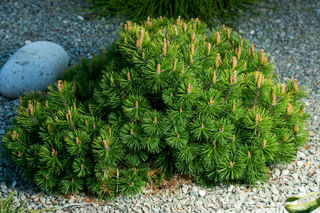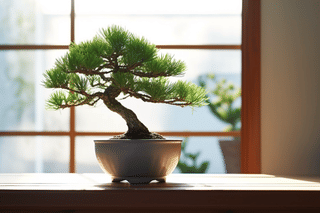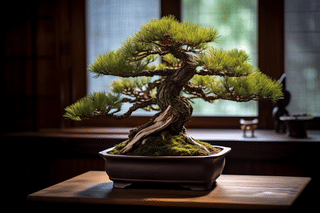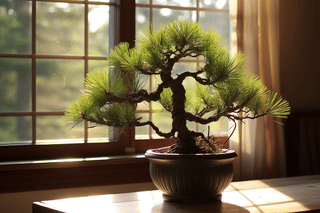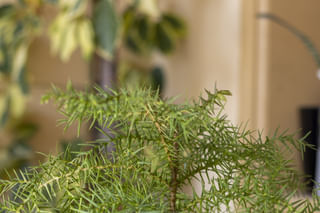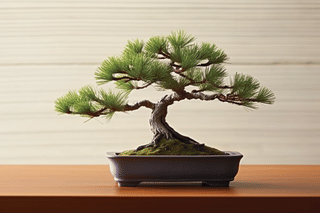6 Pine Trees You Can Grow As Houseplants
Discover the joy of bringing the peaceful beauty of pine trees into your home! This plant guide shares 6 pine trees to use as houseplants that will transform your space. Learn essential care tips and go on an exciting journey of pine trees in your home.
Imagine gazing out your window at a lush, green pine forest and longing to bring a slice of that tranquil beauty into your own home. Well, guess what? It's not only possible but also surprisingly simple!
In this plant care guide, I'll introduce you to a variety of captivating pine species you can grow in the comfort of your own home. This guide will help transform your living space into a mini pine forest complete with the scent of pine needles and the calming presence of greenery.
These are the pine species we're going to look at:
Before we get started, I just want to make sure you know to get your pine forest plants from dedicated growers or garden stores. Don't go out to the forest and dig these plants up yourself.
Let's get started and find out which pine species will grow in your home!
Mugo Pine (Pinus mugo)
The Mugo Pine, also called the Mountain Pine, is a compact conifer that makes an excellent houseplant. With its dense, dark green foliage and ability to thrive in diffused light, it's the perfect choice for bringing a touch of wilderness right into your living room.
When grown indoors, Mugo pines usually reach a maximum height of two feet. They look great in small spaces and can be pruned to fit into even smaller areas. This evergreen is also drought-tolerant, making it easy to care for and maintain.
Mugo pines thrive in bright light but need protection from direct sunlight since their needles are prone to scorching. Make sure your mugo pine gets plenty of light and that it's kept away from a drafty window or door to avoid cold damage.
When it comes to watering, allow the soil to dry out between waterings. Don't let your mugo pine sit in soggy soil as this can lead to root rot.
To effectively fertilize your Mugo Pine, remember that moderation is key. These trees don't need a lot of nutrients, so a slow-release, balanced fertilizer applied in the spring is enough for the year. A recommended formula, such as 10-10-10 (equal parts nitrogen, phosphorous, and potassium), can provide the appropriate nourishment.
Follow the instructions on the fertilizer package carefully to prevent over-fertilization, which could harm the plant.
Japanese White Pine (Pinus parviflora)
The Japanese White Pine (Pinus parviflora), a stunning native of Japan, is a fabulous addition to your houseplant collection. Its lovely bluish-green needles and artistic, windswept look make it a great-looking houseplant. Best of all, this tree can be trained as a bonsai and is well-suited for indoor growing.
Japanese white pines are slow-growing and need very little care. They thrive in bright light but need protection from direct sunlight. Just watch out for the scorching of the needles.
Water your Japanese white pine when the soil feels dry to the touch, making sure it never sits in soggy soil. Feed your Japanese white pine during the spring and summer months with an all-purpose fertilizer to keep it in top condition.
Scots Pine (Pinus sylvestris)
The Scots Pine (Pinus sylvestris) is a rugged and resilient species that brings the charm of the Scottish Highlands into your home. Known for its needle-like leaves that range from blue-green to dark green, this pine is easy to care for and is well-suited to indoor conditions, making it a perfect choice for a houseplant.
The Scots pine is a popular choice for a bonsai project. It has bright, evergreen needles on twisted branches. Its slow-growing nature means it's ideal for small spaces since it won't grow too large.
When caring for your Scots pine, make sure it has plenty of bright light but no direct sunlight. Watering is also important for this species. While it prefers dry soil, it needs to be kept moist during the summer months and watered regularly throughout winter.
When it comes to feeding your Scots Pine, less is more. Use a slow-release, all-purpose fertilizer (10-10-10 formula) only once a year in the springtime. This gives it the right food it needs to grow strong. Always follow the package instructions to avoid giving too much, which can hurt your tree.
Japanese Black Pine (Pinus thunbergii)
The Japanese Black Pine (Pinus thunbergii) is a great-looking pine tree known for its rugged appearance and resilience. Its ability to adapt to a variety of indoor conditions and its beautiful layered branches make it an excellent choice for a unique and low-maintenance houseplant.
The Japanese black pine is an evergreen with deep green needles that can reach heights of up to 50 feet in nature. It's a popular choice for bonsai but can also be grown as a regular houseplant.
This species prefers bright light and lots of air circulation. When it comes to watering, allow the soil to dry out between waterings. Like all other pines, the Japanese black pine is sensitive to overwatering so be extra careful to let any excess water drain from the pot!
You should also fertilize your Japanese black pine during the spring and summer months with an all-purpose fertilizer. This will help keep it healthy and promote vigorous growth.
Parlour Pine (Araucaria cunninghamii)
The Parlour Pine (Araucaria cunninghamii), also known as the Hoop Pine, is a versatile species that makes any living space look incredible. It's famous for its soft, feathery foliage and its ability to adapt well to indoor conditions. It's a great choice for those who want a low-maintenance but aesthetically pleasing houseplant.
The Parlour Pine prefers bright light but can also tolerate low-light conditions. It needs to be watered regularly, allowing the soil to dry out between waterings. Fertilize it during the spring and summer months with an all-purpose fertilizer for optimal growth.
Ponderosa Pine (Pinus ponderosa)
The Ponderosa Pine (Pinus ponderosa) is a majestic species that brings the rustic charm of the American West into your home. While this plant is not as common as some other indoor pine varieties, the Ponderosa Pine can be grown indoors. It has long needles and a distinctive appearance. This tree grows tall, so if you want to keep it indoors permanently, it's best to make a bonsai out of it.
Growing a pine tree like the Ponderosa Pine indoors requires careful attention to the plant's needs. These trees need a lot of sunlight, so they should be placed in a spot that receives plenty of natural light. They also require well-draining soil and regular watering.
When watering your Ponderosa Pine, it's important to have great drainage. Overwatering can lead to root rot, so allow the top of the soil to dry out between watering sessions. This tree naturally has deep roots, so you should water it thoroughly. This is where the excellent drainage comes in. The drainage holes allow the excess water to escape the pot and this helps to avoid any waterlogged soil.
Fertilize your Ponderosa Pine during spring and summer with an all-purpose fertilizer to promote vigorous growth. Keep an eye out for pests such as mites and mealybugs, which can damage the needles if left untreated.
Taking care of a pine tree indoors
We have discovered a few excellent pine species that you can grow indoors. Each of these pine tree species has its unique aesthetic appeal and how you should take care of it. Knowing how to take care of your pine tree will help you to keep it around for many years.
If you happen to find other pine species, some that I haven't covered in this plant care guide, you're in luck! In this section, we will explore the basics of taking care of most of the indoor pine species. Some parts of taking care of these plants are very similar between all different species, so if it works for one of them, it'll most likely work for your pine tree as well.
The importance of sunlight
Firstly, it is crucial to understand the importance of light in the life of an indoor pine tree. These trees, regardless of the species, usually need bright, indirect sunlight to thrive. Find a place in your home that receives a good amount of natural light. If there is no such area, consider using a full-spectrum light bulb to mimic the sun's rays. However, avoid placing your pine tree in direct sunlight since this can scorch its needles and cause damage to the plant.
Watering indoor pine trees
Secondly, watering your indoor pine tree correctly is very important. The key is to not let the tree dry out, but also avoid overwatering. You can find this balance by allowing the top layer of the soil to dry out between watering sessions.
Overwatering can lead to root rot, a common problem for indoor plants where the roots become waterlogged and begin to decay. It's also worth noting that proper drainage is essential for a healthy root system. Be sure to choose a pot with adequate drainage holes and use a well-draining soil mix.
Fertilizing indoor pine trees
Lastly, feeding your pine tree with the right nutrients is just as important as light and water. Most pine trees need a balanced, all-purpose fertilizer, typically with a 10-10-10 formula, which means it contains equal amounts of nitrogen, phosphorus, and potassium (NPK).
These elements help the tree grow strong and healthy. The frequency of fertilization varies depending on the type of pine tree. Some may require feeding only once a year, typically in spring, while others may need fertilization during both spring and summer. Always follow the instructions on the fertilizer package to avoid over-feeding which can harm your tree.
The ideal soil for a pine tree
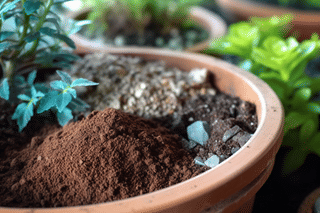
As pine trees typically grow in areas with low soil fertility, they are adapted to getting by with fewer nutrients than some other plants. However, to ensure the best growth and health of your indoor pine tree, it's not a bad idea to use a potting mix enriched with slow-release fertilizer or to add a layer of compost to the top of the soil. This will provide your pine tree with a steady supply of nutrients over a long period. It's also important to note that pine trees don't do well in compacted soil, so avoid packing the soil too tightly in the pot.
To summarize, nurturing an indoor pine tree can be a highly rewarding activity that brings tranquility and natural beauty to your home. It's crucial to provide proper light, water, and fertilization for the health and longevity of your tree. Whether you've chosen a Japanese Black Pine, Parlour Pine, Ponderosa Pine, or another pine tree, understanding the specific needs of your plant will help it thrive.
Thank you for reading this post! I hope it helps you to keep your plants healthy and beautiful! If you're looking for more guides on specific plants, you can always request a plant guide to get a guide for the plant you have trouble with.
Test your plant care knowledge
Quiz completed!
Want to learn more? Sign up for my newsletter to receive free tips in your inbox!
Sign up now!
